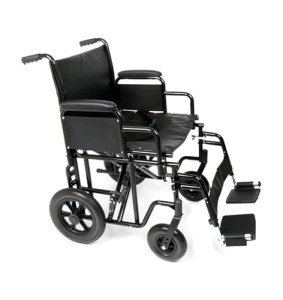Bariatric Transit 24 Inch Wheelchair
A bariatric wheelchair is perfect if you require a chair with a larger seat width and greater weight capacity. This long lasting wheelchair has a nylon cushioned seat that extends 24 inches wide with swing-away footrests. It has considerable 4 caster mobility and attendant locks for safe stops. The heavy-duty slide tube frame can support up to 450 pounds.

Weight Capacity
When choosing a wheelchair for yourself or for a loved one, it is necessary to consider the weight capacity. Basic wheelchairs can accommodate up to 250 pounds, however bariatric chairs have the capability to support as much as 700 pounds. This distinction in capacity is the primary factor that bariatric wheelchairs are stronger and heavier than basic models.
To help chauffeurs safely transport passengers who use bariatric wheelchair s, it is vital to have automobiles equipped with proper equipment. This consists of wheelchair lifts and ramps that can deal with the increased size and weight of the chair. Additionally, drivers must receive training on how to steer these big mobility aids.
The Medline folding extra broad bariatric transport wheelchair has a roomy 24" seat and a carbon steel frame with rust- and chip-resistant chrome plating. inquiry includes easy-to-clean vinyl upholstery and swing-away footrests with a push-button adjustable height function. This heavy-duty wheelchair has a weight capacity of 500 pounds.
When choosing a wheelchair, it is crucial to request for recommendations from a health care supplier or mobility expert. They can examine your physical condition and suggest the finest mobility solution for you. They can likewise assist you determine if Medicare or private insurance coverage covers the expense of your wheelchair.
Wheelchair Frame
A wheelchair frame is the main support group that holds the other elements of the chair. The frames are made from a range of materials, consisting of aluminum, titanium, and carbon fibre. Rigid manual wheelchairs are created with efficiency in mind and use the principles of sports bike frames-- triangles are one of the strongest shapes readily available and engineers have utilized this understanding to design frames that create a stiff system that utilizes less energy for propulsion than more versatile frames.
The option of wheelchair frame is frequently based on the needs and concerns of the client as evaluated by their OT/PT or other clinician. For example, a front frame angle is an essential setup as it affects how well the customer can transfer or self-catheterize. Likewise the seat to footplate height is a crucial factor for placing and balance.
Many wheelchairs have the option to be set up with a fixed or reclining frame. For those who need a more stable chair for stability or for transport in lorries, a fixed frame is best. This is specifically real for those who require a bariatric chair with a larger seat width or higher weight capacity.
Folding frames have a traditional "cross-brace" or X style that allows the chair to fold by bringing the side rails together, although there are other styles readily available for folding chairs, such as a scissor brace frame (Kuschall Champion) which lowers the number of moving parts and for that reason can be lighter than the cross-brace styles. Other alternatives for folding frames consist of swing-away legrests and detachable arms.
Lots of producers also offer a variety of choices for the wheelchair frame front end, such as the frame angle. A 90 degree frame angle puts the feet at a natural position for pressing, while a 75 degree frame angle places the feet more forward. The option of frame angle should be carefully thought about as the more forward position may make it difficult for the wheelchair user to get over obstacles or might cause a wheel capturing on dropped curbs and creating vibration.
Rigid frames are generally made from aluminium, although some models have a dual tube building that resembles the sport frames used in biking, to help increase strength and stability. Carbon Fibre is another material utilized in the frame construction of some wheelchairs, using an even stiffer and lighter frame.
